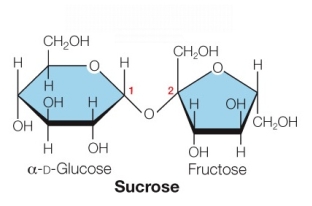Refer to the figure below showing the structure of sucrose.  How would sucrose be expected to differ from the monosaccharide glucose?
How would sucrose be expected to differ from the monosaccharide glucose?
Definitions:
Tyrosine Hydroxylase
An enzyme involved in the synthesis of dopamine, a neurotransmitter crucial for movement, mood regulation, and decision-making.
Ionotropic Receptors
A type of neurotransmitter receptor that forms an ion channel pore, which opens to allow ions to pass through the cell membrane in response to the binding of a neurotransmitter.
Metabotropic Receptors
A type of G-protein coupled receptor found in cells that interacts with neurotransmitters to produce longer-lasting effects through a series of biochemical reactions.
Ion Diffusion
The movement of ions from an area of higher concentration to an area of lower concentration across a permeable barrier.
Q12: Refer to the following table. <img src="https://d2lvgg3v3hfg70.cloudfront.net/TB5650/.jpg"
Q20: Which set of numbers correctly balances the
Q50: An atom of <img src="https://d2lvgg3v3hfg70.cloudfront.net/TB5650/.jpg" alt="An atom
Q51: A simple sugar with the formula C<sub>5</sub>H<sub>10</sub>O<sub>5</sub>
Q64: Leucine and valine have side chains that
Q149: A region of Amazon rainforest has been
Q164: Two important polysaccharides made up of glucose
Q167: Complementary base pairing between nucleotides makes which
Q185: Scientists have observed that in prokaryotes, translation
Q187: Which element is the most chemically reactive?<br>A)